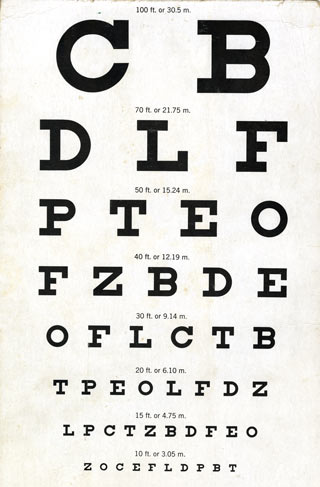Eyeglasses or contacts help you have 20/20 vision. But what does that really mean? The phrase 20/20 vision means normal vision, explains J. Kevin McKinney, MD.
“A person with 20/20 vision can see what an average individual can see on an eye chart when they are standing 20 feet away,” says Dr. McKinney. McKinney is an ophthalmologist and glaucoma specialist at Eye Health Northwest, Oregon City, Ore.
How to read your eye glass prescription
An eye chart measures visual acuity, which is the clearness or sharpness of vision. The top number is your distance in feet from the chart. The bottom number is the distance at which a person with normal eyesight can read the same line.
For example, if you have 20/30 vision, it means your vision is worse than average. Twenty feet away, you can read letters most people see from 30 feet.

A standard Snellen vision testing chart.
Is 20/20 vision considered perfect vision?
20/20 vision is not perfect vision. A person can have 20/15 vision, which is sharper than average. If you have 20/15 vision, you can see a line in the eye chart at 20 feet that the average person can only see when they are 15 feet away. The goal of glasses or contacts is to bring a person’s vision to 20/20.
Dr. McKinney says that only about 35% of all adults have 20/20 vision without glasses, contact lenses or eye surgery. With correction, about 75% of adults have 20/20 vision. In most states, you need 20/40 vision or better for an unrestricted driver’s license. People are “legally blind” if their vision with glasses or contacts is 20/200 or worse.
When should I, or my child, go for a vision test?
Is your child old enough to cooperate with using an eye chart? If so, the American Academy of Ophthalmology recommends you have your child's vision tested. Some children lose their 20/20 vision around age 8 or 9. This is according to Tim Johnson, MD, associate professor of ophthalmology and director of Comprehensive Ophthalmology Services at University of Iowa Hospitals and Clinics. After that age, most people’s visual acuity stays the same. It may decrease slightly as people reach their 60s or 70s.
When you reach middle age, your visual acuity will likely not change. But you may lose your near vision. Your eyes' lenses become less able to bend. It becomes harder to change focus from far away to close. This is presbyopia. You may need reading glasses or bifocals to fix the problem.
Outside the U.S., eyecare providers measure vision in meters instead of feet. Instead of 20/20 vision, the goal is 6/6.
Eyecare providers measure your visual acuity as part of an eye exam. Follow these important guidelines for when to have your child’s eyes examined. Even if you have 20/20 vision, you need eye exams as you age. The Academy recommends that you get a baseline eye examination at age 40. This is when early signs of disease or vision changes may happen.